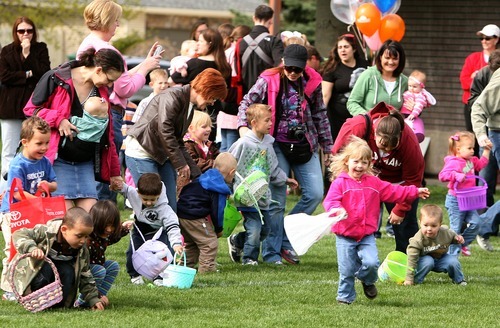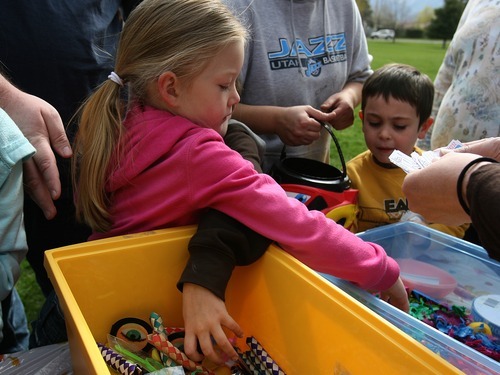This is an archived article that was published on sltrib.com in 2011, and information in the article may be outdated. It is provided only for personal research purposes and may not be reprinted.
Hard-boiled eggs, milk-chocolate rabbits and peanut-butter cups in pastel wrappers are an essential part of Easter for many families.
But for the 32,000 Utah children with food allergies, those seemingly harmless candies can be life-threatening.
To help kids with allergies have a normal Easter, the Utah Food Allergy Network sponsored its first Easter egg hunt Saturday. UFAN hopes to make the event an annual tradition, giving children with allergies a safe place to celebrate the holiday.
"Food is like a loaded gun, and it's everywhere," said organizer Maryann Alston, whose son Jack has a severe peanut allergy.
Children had a chance to visit with the Easter bunny at Murray's Southwood Park, before heading off to hunt plastic eggs filled with small toys. The event was completely free of food, allowing children like 3-year-old Caden Scherbel to hunt without the fear of parents taking away treats. Caden is allergic to all food, explained his mother Tiffany Scherbel, and must receive all of his nutrients through a feeding tube.
"He's just starting to realize he's a little different," Scherbel said.
A normal Easter event is extremely difficult for a child with food allergies, Scherbel said. Kids get upset they can't keep their candy, and Caden has left some parties in tears. His allergies to foods like wheat, milk and eggs can be reactive on simple contact with his skin, Scherbel said. When children open their regular Easter eggs full of candy and begin eating, they pick up particles of those foods, and can spread them to Caden by contact or touching the same toys.
Having a sibling without allergies can make things even more difficult, explained Melissa Curran. Her 7-year-old, Gabriel, has a peanut allergy, but her 1-year-old daughter, Everleigh, does not. Trying to find candy that is safe for both of them — he can have Skittles, they are a choking hazard for her, she can have chocolate, for him it could trigger a reaction — is always a challenge.
"They always put candy in the eggs," Curran said, adding that she has never offered to take Gabriel to other events because he can't have any of the prizes. "This allows him to participate."
Gabriel was delighted with his haul, which included silly band bracelets, funky pencils and erasers and a hacky sack. Children also found tickets to exchange for larger items like coloring books, bouncy balls and plastic animals.
The most common food allergens are milk, eggs, peanuts, tree nuts, wheat, soy, fish and shellfish, said UFAN president Michelle Fogg, and many children have more than one allergy. Some can be outgrown, like milk or eggs, but most children who are still allergic at age 5 will have to avoid that food for life.
"There's no cure for food allergies," Fogg stressed. "The only treatment available right now is avoidance."
Holidays are especially hard for allergy sufferers, Fogg explained, because food is such a huge part of any culture. School celebrations, birthday parties and holidays are all difficult, with Halloween topping most parents' list as the most troublesome.
"I don't think we have to have food to have fun," Fogg said. "Let's get away from food-based rewards. It will be healthier for everyone." —
Food-allergy meeting
P The Utah Food Allergy Network hosts a variety of events throughout the year and is planning its first Utah Food Allergy Conference for June 25. For more information, or to find other families with food allergies, visit > http://www.utahfoodallergy.org.





